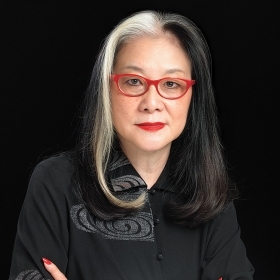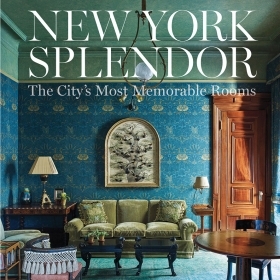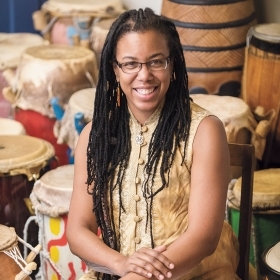Clarivel with Black Blouse with White Ribbon, 2016, Mickalene Thomas
Epson Inkjet print with HDF Ultrachrome inks, 26 1/16 in. x 20 13/16 in.
Museum purchase, The Nancy Gray Sherrill ’54 Collection Acquisition Fund 2017.34
Photo ©2019 Mickalene Thomas/Artists Rights Society (ARS), New York
Contemporary artist Mickalene Thomas (b. 1971) has always mined the formal and symbolic vocabulary of art history, particularly the work of canonical male modernists such as Manet, Matisse, and Picasso, to invest her representations of black women with complex meaning. Her recent print, Clarivel with Black Blouse with White Ribbon, relates to a larger group of collages and paintings that also depict the named subject Clarivel. The first work by Thomas to enter the Davis Museum’s collection, Clarivel exemplifies the artist’s powerful representations of assertive female imagery and makes a unique and important addition to the museum’s presentation of changing traditions in portraiture.
Traditional portraiture dating back to the Renaissance celebrated wealthy and powerful subjects, and typically situated a torso-length subject against a domestic interior, often with a distant landscape glimpsed through a window. Thomas both capitalizes upon and disrupts that formal iconography to invest her subject with authority. Her subject’s erect posture, gently turned head, and elegantly piled hairdo dominate the composition. Elements of wood paneling evoke an interior space on the left side, and on the right, a fern pattern and a spare, geometric representation of trees reference a wooded scene in the distance.
Although the work is a seamless print, the image evokes Thomas’ signature collage technique to imply the constructed nature of identity. The all-over pattern of tiny white bows on Clarivel’s dress, specifically mentioned in the work’s title, obscures the cut and pasted edges of collage elements that serve to broaden the subject’s shoulders and expand her presence in the visual field. Most importantly, Thomas has cut and removed the eyes from her subject’s face, replacing them with a pair of eyes that seem to be layered behind the face. Clarivel’s eyes not only engage directly with the viewer, but also invest the exchange with the subject’s potent interior vision.
Amanda Gilvin, assistant curator at the Davis Museum, explains, “Mickalene Thomas’ portraits celebrate black women’s beauty, glamour, and style. Thomas’ collage-based techniques in both painting and printmaking require you to look closely—and in this case, to be aware of how this woman, Clarivel, looks back at us.” Most intriguingly, a second “portrait” appears in this work at the upper left, in the form of blind musician Stevie Wonder on the cover of his 1980 album, Hotter Than July. Wonder’s dark glasses provide a counterpoint to Clarivel’s bright, direct gaze, and propose a complicated dynamic between the print’s various subjects—female and male, primary and secondary, Clarivel (unknown to most viewers) and Stevie (a widely known celebrity).
In a 2011 interview published in BOMB magazine, Thomas acknowledged herself as the inevitable first “viewer” of the work and explained, “the fact that the gaze in question is from one woman to another is more powerful, to me, than the male gaze. But I think the female gaze is still connected to the concept of the male gaze; we are all shaped by the dominant cultural norms. At the same time, I can’t say that … my own desires have nothing to do with the types of gaze I’m interested in.” Clarivel with Black Blouse with White Ribbon offers a striking new addition to the Davis Museum’s collection where it will not only be seen by a wide public audience, but also studied by an academic community that celebrates the power and agency of the female gaze.








We ask that those who engage in Wellesley magazine's online community act with honesty, integrity, and respect. (Remember the honor code, alums?) We reserve the right to remove comments by impersonators or comments that are not civil and relevant to the subject at hand. By posting here, you are permitting Wellesley magazine to edit and republish your comment in all media. Please remember that all posts are public.